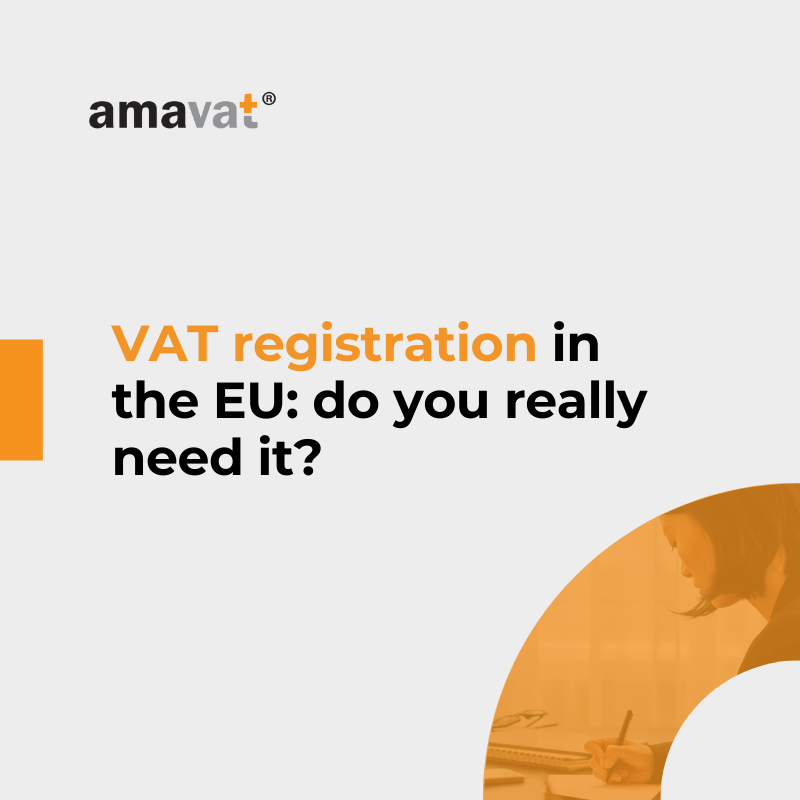VAT registration in the EU: do you really need it

Spis treści
Expanding into the European Union can open up exciting opportunities for international growth — but it also introduces new regulatory responsibilities, particularly around Value-Added Tax (VAT).
For many businesses selling goods or services into the EU, a common and critical question arises: Do I really need to register for VAT? And while the answer may seem straightforward, the reality is more nuanced. It depends on several key factors, including your sales volume, your customer base, and the type of products or services you offer.
One threshold you’ll hear about often is €10,000 — a seemingly modest figure that can have significant tax implications if crossed. So whether you’re running a SaaS business, shipping physical products, or offering digital services to EU consumers, it’s essential to understand exactly where you stand.
In this guide, we’ll unpack when VAT registration becomes mandatory, when it might be optional, and why getting it right from the start is crucial. The rules can be complex — but the consequences of ignoring them are even more so. Let’s clarify what really applies to your business.
The basics: what is VAT and why should you care?
If you’re running a business within the European Union, you’re likely already familiar with VAT – Value-Added Tax. It’s a standard part of doing business in the EU, applied to most goods and services at various points in the supply chain. But when it comes to cross-border sales, especially in the digital space or to consumers in other Member States, VAT rules can quickly become more complex — and more relevant than ever.
So, what exactly is VAT?
VAT is a consumption tax that’s ultimately paid by the end customer, but collected and reported by the businesses involved in the sale. Unlike sales tax systems used elsewhere, VAT is charged at each stage of production and distribution. Businesses pay VAT on their purchases and charge VAT on their sales — with the ability to reclaim the VAT they’ve paid (input VAT) from what they’ve collected (output VAT).
This system ensures that tax is paid based on the value added at each stage of the supply chain, hence the name.
Why does it matter for your business?
Because when you’re selling across borders within the EU — whether it’s physical goods, digital services, or anything in between — your VAT obligations don’t stop at your country’s borders.
In many cases, you may be required to:
- Register for VAT in another Member State (or under the OSS scheme),
- Charge VAT at the rate applicable in your customer’s country,
- File VAT returns according to local rules.
Failing to do so doesn’t just result in administrative headaches — it can lead to penalties, interest charges, and reputational risk. Understanding how VAT works is essential not only for compliance, but also for pricing strategy, cash flow planning, and maintaining customer trust.
When you must register for VAT in the EU
Let’s be clear: in some cases, VAT registration isn’t optional — it’s required. Whether you’re selling digital services, shipping products, or operating across borders, there are specific scenarios where registration becomes mandatory under EU law.
Here are the key situations to watch out for:
Selling to EU customers (B2C Sales)
If you sell goods or services directly to consumers (i.e. individuals who are not VAT-registered businesses) in other EU Member States, the EU-wide threshold of €10,000 applies.
Once your total annual cross-border B2C sales exceed this threshold, you are required to charge VAT based on the customer’s country, not your own. This applies regardless of where your business is established within the EU.
This is particularly relevant for:
- E-commerce businesses shipping goods to EU consumers,
- Digital service providers offering downloadable content, software, or online subscriptions.
In these cases, you must either:
➜ Register for VAT in each Member State where your customers are located, or
➜ Register for the VAT One Stop Shop (OSS) scheme, which allows for simplified reporting through a single registration.
Intra-community trade
Businesses engaging in intra-Community transactions — that is, trading goods or certain services between EU Member States — may also be required to register for VAT.
This includes:
➜ Intra-Community acquisitions: purchasing goods from another Member State,
➜ Intra-Community supplies: selling goods to VAT-registered businesses in another Member State.
Each country sets its own threshold for intra-Community acquisitions. For instance:
➜ In Poland, VAT registration is required when such acquisitions exceed PLN 50,000 in a calendar year.
Failing to register when these thresholds are crossed can result in penalties and backdated VAT obligations.
Non-established businesses
If your business is not established within the EU but engages in taxable activities in one or more EU member states, you may be required to register for VAT in each relevant country. This obligation depends on the type of activity and the nature of your transactions.
Typical scenarios include:
- Selling goods to EU-based consumers,
- Providing digital services to customers located in the EU,
- Storing inventory in EU warehouses (e.g., through fulfilment or dropshipping models).
For non-established businesses, there is often no VAT registration threshold—meaning registration may be required from the very first taxable transaction.
To simplify VAT compliance, non-EU businesses may use the One Stop Shop (OSS) or Import One Stop Shop (IOSS) schemes, depending on their sales model. The OSS scheme is available for B2C cross-border supplies of digital services and distance sales of goods within the EU, allowing businesses to avoid multiple local registrations. However, for other activities—such as storing goods in EU warehouses—local VAT registration in each country remains necessary.
B2C vs. B2B: understanding the difference
The distinction between Business-to-Consumer (B2C) and Business-to-Business (B2B) sales is fundamental in determining your VAT obligations.
➜ For B2C transactions, the seller is generally required to register, collect, and remit VAT based on the customer’s location.
➜ For B2B transactions, especially involving digital services, the reverse charge mechanism may apply. In this case, the VAT responsibility shifts to the buyer, and you may not need to register for VAT in the customer’s country.
To apply the reverse charge mechanism properly, it is essential that:
- The buyer is VAT-registered in their Member State,
- The invoice clearly states that the reverse charge applies,
- No physical goods are being shipped that would otherwise trigger different VAT rules.
The bright side: benefits of registering
VAT registration is often viewed as a necessary obligation — and in many cases, it is. But beyond compliance, registering for VAT can offer several tangible advantages that support the growth, credibility, and financial efficiency of your business, particularly when operating across EU borders.
Confidence in compliance
First and foremost, VAT registration provides clarity. When you’re properly registered, you remove uncertainty around your tax obligations. You know exactly where you stand — and so do the authorities.
This not only helps you avoid penalties, late fees, or audits, but also allows you to focus on what matters most: running your business with confidence and peace of mind.
Stronger business reputation
For many customers, especially within the EU’s B2B landscape, a valid VAT number is more than just a tax detail — it’s a signal of credibility.
Being VAT registered demonstrates that your business is structured, compliant, and serious about operating across borders. It builds trust with clients, suppliers, and partners alike, and may even be a prerequisite for collaboration in certain industries or public procurement processes.
The ability to reclaim input VAT
Once registered, your business typically gains the right to reclaim VAT paid on eligible purchases, including goods, services, tools, and operational costs. This can have a meaningful impact on your cash flow, particularly if you work with EU-based suppliers or invest regularly in business development.
Put simply: you can stop treating VAT as a cost and start treating it as a recoverable outlay.
Smoother cross-border operations
If you’re selling to customers in multiple EU countries, VAT registration — especially under the One Stop Shop (OSS) — can make cross-border compliance significantly more manageable.
Rather than registering in each Member State where you do business, the OSS allows you to report and pay VAT for all qualifying B2C sales through a single return, filed in your country of establishment. This not only simplifies your tax obligations but also reduces administrative overhead and the risk of errors.
How to register for VAT in the EU
Once you determine that VAT registration is necessary for your business, the next step is getting the process right — and ideally, keeping it as efficient and stress-free as possible. While procedures differ slightly from country to country, the overall structure is similar across the EU. Here’s a practical breakdown of how it works.
Step-by-step: how the process typically looks
- Confirm Whether You’re Over the Threshold
Before initiating the registration process, check if you actually need to register. The key question is: have your annual B2C sales to customers in other EU Member States exceeded €10,000?
This applies to cross-border sales of both physical goods and digital services. If the answer is yes, you’re likely required to register for VAT — either locally in those countries or via the OSS scheme (more on that in a moment).
- Gather the Required Documentation
Each Member State may have slightly different requirements, but in most cases, you’ll need to prepare:
-
- Your company’s certificate of incorporation or trade registration,
- A valid tax identification number (TIN),
- Proof of identity for company directors or legal representatives,
- Information about your business activities and recent transactions.
It’s a good idea to have documents ready in both English and, where possible, the local language of the country where you’re registering.
- Submit the Application to the Relevant Tax Authority
VAT registration must be completed through the national tax office of the country in which the obligation arises. Many Member States require the application to be submitted in their official language, and communication with tax authorities is often handled locally as well.
If you’re not familiar with the local procedures or language, it may be worthwhile to engage a tax advisor or fiscal representative to assist you.
- Receive Your VAT Identification Number
Once your registration is approved, you will receive a VAT number specific to that country, prefixed with its country code — for example, PL for Poland or DE for Germany.
From this point on, you are officially VAT-registered in that jurisdiction and must apply the correct VAT rates, issue compliant invoices, and submit regular VAT returns as required.
Use the One Stop Shop (OSS) if…
If you’re selling to customers in multiple EU Member States, registering individually in each country can quickly become time-consuming and administratively complex. That’s where the OSS (One Stop Shop) scheme comes in.
The OSS allows eligible businesses to:
- Register in one EU Member State (typically where the business is established),
- Report and remit VAT for all cross-border B2C sales across the EU via a single quarterly return, and
- Avoid the need to register separately in every country where customers are based.
This system is particularly beneficial for e-commerce businesses and digital service providers, and it’s designed to streamline compliance while maintaining full transparency for tax authorities.
When you might not need to register
VAT rules in the EU can feel strict — and in many cases, they are. But not every business is required to register right away. In fact, there are a few situations where you might be off the hook, at least for now.
Here’s when VAT registration might not be necessary:
Your sales are below the €10,000 threshold
If you’re just starting out with cross-border sales — or your EU-wide B2C turnover is still relatively low — there’s good news. As long as your total annual sales to EU consumers stay under €10,000, you’re not required to register for VAT in other Member States.
Instead, you can charge VAT at your local (home country) rate, report it through your national VAT system, and skip the extra admin — at least until your sales grow.
But keep in mind: the €10,000 is a combined threshold across all EU countries, not per country. And once you cross it, you’ll need to switch to destination-based VAT (and possibly register or use the OSS).
You’re selling B2B digital products (and the reverse charge applies)
If your business provides digital products or services (like SaaS, online tools, or digital downloads) to other VAT-registered businesses in the EU, you may not need to register in their country — thanks to something called the reverse charge mechanism.
In these cases:
- The buyer takes care of the VAT on their end,
- You don’t charge VAT on the invoice,
- And you usually don’t need to register in the customer’s country.
Just make sure:
- The buyer is VAT-registered and provides a valid VAT number,
- Your invoices clearly state that the reverse charge applies.
This setup simplifies things quite a bit — but it only works for B2B, not B2C sales.
You’re a micro digital seller using home-country VAT
Selling digital services to individual consumers in the EU but still well below that €10,000 threshold? Then you can continue to apply your home country’s VAT rate and report those sales through your local system.
This is a great option for freelancers, creators, and micro-businesses offering things like online workshops, e-books, or downloads. It’s low-maintenance, legally sound, and saves you from dealing with VAT registration across multiple countries — at least until your business scales up.
Summary
Navigating VAT rules in the EU might seem complex at first, but once you understand the key triggers, it becomes much easier to assess your obligations — and act with confidence.
If you’re still unsure whether VAT registration applies to your business, start with a simple checklist:
Ask Yourself:
- Have your total B2C sales to EU countries exceeded €10,000 in the last 12 months?
- Are you selling to private individuals (not just businesses) within the EU?
- Do you offer digital products or services, such as online content, software, or subscriptions?
- Are you a non-EU business making taxable supplies to EU customers?
If you answered “yes” to any of the above, it’s very likely that VAT registration is required — either in individual Member States or through the One Stop Shop (OSS) scheme.
And even if you’re currently below the threshold, it’s worth monitoring your sales closely. Growth can happen quickly, and VAT obligations can arise before you realise it.
Final thought: don’t guess — assess
VAT registration isn’t just about ticking a compliance box — it’s about building a business that’s sustainable, credible, and ready to scale.
If you’re unsure about your next steps, seek guidance from a specialist or consult the official EU VAT portals. The rules may be complex, but the process doesn’t have to be overwhelming.
When in doubt, take action early. With VAT, it’s always better to be prepared than to be caught off guard.







